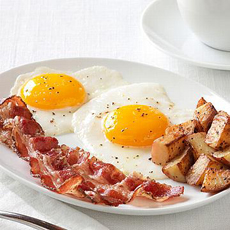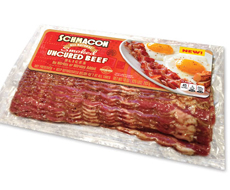|
The producer calls Schmacon “beef’s answer to bacon.”
It looks like bacon and smells bacon; it cooks like bacon–preferably in the oven for maximum crispness, although it can be cooked in a frying pan.
The result, crisp strips of Schmacon, tastes of beef instead of pork, but with the smoky, sweet spirit of bacon.
A serving of Schmacon contains 30 calories, 2 g fat, and 60 mg sodium.
A serving of pork bacon averages 60-90 calories, 4.5-7 g fat, and 190-360 mg sodium.
Meatier, lower in sodium, calories and fat, Schmacon is a much healthier alternative, and you get more meat and less fat. More benefits:
Schmacon cooks in half the time of raw pork bacon.
It generates much less grease; and, as with bacon grease, you can use it to cook potatoes and eggs, make German potato salad, etc.
For everyone without a great kitchen exhaust fan: There’s no lingering smell of old bacon fat in the air.
|
|

Crisp, delicious Schmacon. Use it wherever you’d use bacon. Photo courtesy Schmacon. |
We think it’s terrific, and so does the trade: The National Restaurant Association gave Schmacon its Food and Beverage Innovations Award.
THREE YEARS IN DEVELOPMENT
This is not the first beef bacon on the market, but but it’s head and shoulders above the rest. Most other beef bacon is manufactured with the same technique as pork bacon, but that made no sense to CEO Howard Bender. He started from scratch, testing different cuts of beef, spice blends and cooking processes until, three years later, he was satisfied.
The result, Schmacon Smoked & Glazed Beef Slices, is an achievement, a delicious alternative for those who do not eat pork products, and a boon to those who’d like “healthier bacon.”
Why isn’t it called bacon? Today, the USDA limits the use of “bacon” to pork. “Turkey bacon” got grandfathered in.
|





